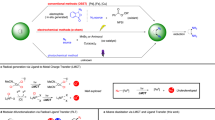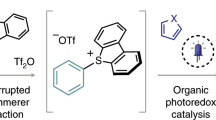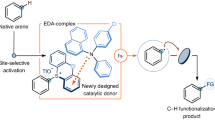Abstract
Vicinal diamines, especially unsymmetrical ones, are among the most common structural motifs in biologically active molecules, natural products and pharmaceuticals. While the catalytic diamination of carbon–carbon double bonds provides rapid access to diamines, these reactions are often limited to installation of undifferentiated amino functionalities through transition metals or hypervalent iodine reagent catalysis. Herein we disclose a metal-free, photosensitized dearomative unsymmetrical diamination of various electron-rich (hetero)arenes with bifunctional diamination reagents, producing a series of previously inaccessible vicinal diamines with excellent regio- and diastereoselectivity. A class of bifunctional nitrogen-radical precursors was developed to simultaneously generate two N-centred radicals with different reactivity via an energy transfer process. In addition, the protocol was also found suitable for a wide range of alkenes. Notably, the formed vicinal diamines bear two differentiated amino functionalities, and either imine or amide units could readily and orthogonally be converted to unprotected amines, thereby facilitating selective downstream transformations.

This is a preview of subscription content, access via your institution
Access options
Access Nature and 54 other Nature Portfolio journals
Get Nature+, our best-value online-access subscription
$29.99 / 30 days
cancel any time
Subscribe to this journal
Receive 12 digital issues and online access to articles
$119.00 per year
only $9.92 per issue
Buy this article
- Purchase on Springer Link
- Instant access to full article PDF
Prices may be subject to local taxes which are calculated during checkout






Similar content being viewed by others
Data availability
Materials and methods, experimental procedures, mechanistic studies, computational studies, sensitivity assessment and nuclear magnetic resonance (NMR) spectra are available in the Supplementary Information. Crystallographic information data files and xyz coordinates of the optimized structures are available as Supplementary files. Crystallographic data for the structures reported in this article have been deposited at the Cambridge Crystallographic Data Centre under deposition nos. CCDC 2145161 (21) and 2145162 (66). Copies of crystallographic data can be obtained free of charge via https://www.ccdc.cam.ac.uk/structures/. All other data are available from the authors upon reasonable request.
References
Ricci, A. Amino Group Chemistry: From Synthesis to the Life Sciences (Wiley, 2008).
Lucet, D., Le Gall, T. & Mioskowski, C. The chemistry of vicinal diamines. Angew. Chem. Int. Ed. Engl. 37, 2580–2627 (1998).
Newhouse, T., Lewis, C. A., Eastman, K. J. & Baran, P. S. Scalable total syntheses of N-linked tryptamine dimers by direct indole-aniline coupling: psychotrimine and kapakahines B and F. J. Am. Chem. Soc. 132, 7119–7137 (2010).
Kizirian, J.-C. Chiral tertiary diamines in asymmetric synthesis. Chem. Rev. 108, 140–205 (2008).
Cardona, F. & Goti, A. Metal-catalysed 1,2-diamination reactions. Nat. Chem. 1, 269–275 (2009).
Jong, S., de, Nosal, D. G. & Wardrop, D. J. Methods for direct alkene diamination, new & old. Tetrahedron 68, 4067–4105 (2012).
Chong, A. O., Oshima, K. & Sharpless, K. B. Synthesis of dioxobis(tert-alkylimido)osmium(VIII) and oxotris(tert-alkylimido)osmium(VIII) complexes. Stereospecific vicinal diamination of olefins. J. Am. Chem. Soc. 99, 3420–3426 (1977).
Becker, P. N., White, M. A. & Bergman, R. G. A new method for 1,2-diamination of alkenes using cyclopentadienylnitrosylcobalt dimer/NO/LiAlH4. J. Am. Chem. Soc. 102, 5676–5677 (1980).
Bar, G. L. J., Lloyd-Jones, G. C. & Booker-Milburn, K. I. Pd(II)-catalyzed intermolecular 1,2-diamination of conjugated dienes. J. Am. Chem. Soc. 127, 7308–7309 (2005).
Zhao, B., Du, H., Cui, S. & Shi, Y. Synthetic and mechanistic studies on Pd(0)-catalyzed diamination of conjugated dienes. J. Am. Chem. Soc. 132, 3523–3532 (2010).
Röben, C., Souto, J. A., González, Y., Lishchynskyi, A. & Muñiz, K. Enantioselective metal-free diamination of styrenes. Angew. Chem. Int. Ed. Engl. 50, 9478–9482 (2011).
Zhao, B. et al. Cu(I)-catalyzed diamination of conjugated dienes. Complementary regioselectivity from two distinct mechanistic pathways involving Cu(II) and Cu(III) species. J. Am. Chem. Soc. 133, 20890–20900 (2011).
Zhu, Y., Cornwall, R. G., Du, H., Zhao, B. & Shi, Y. Catalytic diamination of olefins via N–N bond activation. Acc. Chem. Res. 47, 3665–3678 (2014).
Fumagalli, G., Rabet, P. T. G., Boyd, S. & Greaney, M. F. Three-component azidation of styrene-type double bonds: light-switchable behavior of a copper photoredox catalyst. Angew. Chem. Int. Ed. Engl. 54, 11481–11484 (2015).
Yuan, Y.-A., Lu, D.-F., Chen, Y.-R. & Xu, H. Iron-catalyzed direct diazidation for a broad range of olefins. Angew. Chem. Int. Ed. Engl. 55, 534–538 (2016).
Fu, N., Sauer, G. S., Saha, A., Loo, A. & Lin, S. Metal-catalyzed electrochemical diazidation of alkenes. Science 357, 575–579 (2017).
Muñiz, K., Barreiro, L., Romero, R. M. & Martínez, C. Catalytic asymmetric diamination of styrenes. J. Am. Chem. Soc. 139, 4354–4357 (2017).
Shen, S.-J., Zhu, C.-L., Lu, D.-F. & Xu, H. Iron-catalyzed direct olefin diazidation via peroxyester activation promoted by nitrogenbased ligands. ACS Catal. 8, 4473–4482 (2018).
Fu, N., Sauer, G. S. & Lin, S. A general, electrocatalytic approach to the synthesis of vicinal diamines. Nat. Protoc. 13, 1725–1743 (2018).
Siu, J. C., Parry, J. B. & Lin, S. Aminoxyl-catalyzed electrochemical diazidation of alkenes mediated by a metastable charge-transfer complex. J. Am. Chem. Soc. 141, 2825–2831 (2019).
Cai, C.-Y., Shu, X.-M. & Xu, H.-C. Practical and stereoselective electrocatalytic 1,2-diamination of alkenes. Nat. Commun. 10, 4953–4959 (2019).
Tao, Z., Gilbert, B. B. & Denmark, S. E. Catalytic, enantioselective syn-diamination of alkenes. J. Am. Chem. Soc. 141, 19161–19170 (2019).
Minakata, S., Miwa, H., Yamamoto, K., Hirayama, A. & Okumura, S. Diastereodivergent intermolecular 1,2-diamination of unactivated alkenes enabled by iodine catalysis. J. Am. Chem. Soc. 143, 4112–4118 (2021).
Southgate, E. H., Pospech, J., Fu, J., Holycross, D. R. & Sarlah, D. Dearomative dihydroxylation with arenophiles. Nat. Chem. 8, 922–928 (2016).
Wertjes, W. C., Okumura, M. & Sarlah, D. Palladium-catalyzed dearomative syn-1,4-diamination. J. Am. Chem. Soc. 141, 163–167 (2019).
Wu, J., Dou, Y., Guillot, R., Kouklovsky, C. & Vincent, G. Electrochemical dearomative 2,3-difunctionalization of indoles. J. Am. Chem. Soc. 141, 2832–2837 (2019).
Wang, D., Yu, H., Sun, S. & Zhong, F. Intermolecular vicinal diaminative assembly of tetrahydroquinoxalines via metal-free oxidative [4+2] cycloaddition strategy. Org. Lett. 22, 2425–2430 (2020).
Liu, J. et al. Diastereoselective 2, 3-diazidation of indoles via copper(II)-catalyzed dearomatization. Chin. Chem. Lett. 31, 1332–1336 (2020).
Wang, M.-M., Nguyen, T. V. T. & Waser, J. Diamine synthesis via the nitrogen-directed azidation of σ- andπ‑C-C Bonds. J. Am. Chem. Soc. 143, 11969–11975 (2021).
Li, G., Wei, H.-X., Kim, S. H. & Carducci, M. D. A novel electrophilic diamination reaction of alkenes. Angew. Chem. Int. Ed. Engl. 40, 4277–4280 (2001).
Jiang, H., Nielsen, J. B., Nielsen, M. & Jørgensen, K. A. Organocatalysed asymmetric β-amination and multicomponent syn-selective diamination of α,β-unsaturated aldehydes. Chem. Eur. J. 13, 9068–9075 (2007).
Simmons, B., Walji, A. M. & MacMillan, D. W. C. Cycle-specific organocascade catalysis: application to olefin hydroamination, hydro-oxidation, and amino-oxidation, and to natural product synthesis. Angew. Chem. Int. Ed. Engl. 48, 4349–4353 (2009).
Iglesias, A. ́, Pérez, E. G. & Muñiz, K. An intermolecular palladium-catalyzed diamination of unactivated alkenes. Angew. Chem. Int. Ed. Engl. 49, 8109–8111 (2010).
Martínez, C. & Muñiz, K. Palladium-catalyzed vicinal difunctionalization of internal alkenes: diastereoselective synthesis of diamines. Angew. Chem. Int. Ed. Engl. 51, 7031–7034 (2012).
Zhang, H. et al. Copper-catalyzed intermolecular aminocyanation and diamination of alkenes. Angew. Chem. Int. Ed. Engl. 52, 2529–2533 (2013).
Zhang, B. & Studer, A. Copper-catalyzed intermolecular aminoazidation of alkenes. Org. Lett. 16, 1790–1793 (2014).
Olson, D. E., Su, J. Y., Roberts, D. A. & Du Bois, J. Vicinal diamination of alkenes under Rh-catalysis. J. Am. Chem. Soc. 136, 13506–13509 (2014).
Ciesielski, J., Dequirez, G., Retailleau, P., Gandon, V. & Dauban, P. Rhodium-catalyzed alkene difunctionalization with nitrenes. Chem. Eur. J. 22, 9338–9347 (2016).
Govaerts, S. et al. Photoinduced olefin diamination with alkylamines. Angew. Chem. Int. Ed. Engl. 59, 15021–15028 (2020).
Makai, S., Falk, E. & Morandi, B. Direct synthesis of unprotected 2-azidoamines from alkenes via an iron-catalyzed difunctionalization reaction. J. Am. Chem. Soc. 142, 21548–21555 (2020).
Fan, Z., Wang, Z., Shi, R. & Wang, Y. Dirhodium(II)-catalyzed diamination reaction via a free radical pathway. Org. Chem. Front. 8, 5098–5104 (2021).
Xuan, J. & Xiao, W.-J. Visible-light photoredox catalysis. Angew. Chem. Int. Ed. Engl. 51, 6828–6838 (2012).
Narayanam, J. M. R. & Stephenson, C. R. J. Visible light photoredox catalysis: applications in organic synthesis. Chem. Soc. Rev. 40, 102–113 (2011).
Prier, C. K., Rankic, D. A. & MacMillan, D. W. C. Visible light photoredox catalysis with transition metal complexes: applications in organic synthesis. Chem. Rev. 113, 5322–5363 (2013).
Skubi, K. L., Blum, T. R. & Yoon, T. P. Dual catalysis strategies in photochemical synthesis. Chem. Rev. 116, 10035–10074 (2016).
Stephenson, C. R. J., Yoon, T. & MacMillan, D. W. C. Visible Light Photocatalysis in Organic Chemistry (Wiley, 2018).
Zard, S. Z. Recent progress in the generation and use of nitrogen-centred radicals. Chem. Soc. Rev. 37, 1603–1618 (2008).
Chen, J.-R., Hu, X.-Q., Lu, L.-Q. & Xiao, W.-J. Visible light photoredox-controlled reactions of N-radicals and radical ions. Chem. Soc. Rev. 45, 2044–2056 (2016).
Kärkäs, M. D. Photochemical generation of nitrogen-centered amidyl, hydrazonyl, and imidyl radicals: methodology developments and catalytic applications. ACS Catal. 7, 4999–5022 (2017).
Jackman, M. M., Cai, Y. & Castle, S. L. Recent advances in iminyl radical cyclizations. Synthesis 49, 1785–1795 (2017).
Zhao, Y. & Xia, W. Recent advances in radical-based C–N bond formation via photo-/electrochemistry. Chem. Soc. Rev. 47, 2591–2608 (2018).
Davies, J., Morcillo, S. P., Douglas, J. J. & Leonori, D. Hydroxylamine derivatives as nitrogen-radical precursors in visible-light photochemistry. Chem. Eur. J. 24, 12154–12163 (2018).
Strieth-Kalthoff, F., James, M. J., Teders, M., Pitzer, L. & Glorius, F. Energy transfer catalysis mediated by visible light: principles, applications, directions. Chem. Soc. Rev. 47, 7190–7202 (2018).
Zhou, Q.-Q., Zou, Y.-Q., Lu, L.-Q. & Xiao, W.-J. Visible-light-induced organic photochemical reactions through energy-transfer pathways. Angew. Chem. Int. Ed. Engl. 58, 1586–1604 (2019).
Strieth-Kalthoff, F. & Glorius, F. Triplet energy transfer photocatalysis: unlocking the next level. Chem 6, 1888–1903 (2020).
Jiang, H. & Studer, A. Amidyl radicals by oxidation of α-amido-oxy acids: transition-metal-free amidofluorination of unactivated alkenes. Angew. Chem. Int. Ed. Engl. 57, 10707–10711 (2018).
Jiang, H., Seidler, G. & Studer, A. Carboamination of unactivated alkenes through three-component radical conjugate addition. Angew. Chem. Int. Ed. Engl. 58, 16528–16532 (2019).
Patra, T., Das, M., Daniliuc, C. G. & Glorius, F. Metal-free, photosensitized oxyimination of unactivated alkenes with bifunctional oxime carbonates. Nat. Catal. 4, 54–61 (2021).
Pitzer, L., Schäfers, F. & Glorius, F. Rapid assessment of the reaction-condition-based sensitivity of chemical transformations. Angew. Chem. Int. Ed. Engl. 58, 8572–8576 (2019).
Nikitas, N. F., Gkizis, P. L. & Kokotos, C. G. Thioxanthone: a powerful photocatalyst for organic reactions. Org. Biomol. Chem. 19, 5237–5253 (2021).
Fische, H. The persistent radical effect: a principle for selective radical reactions and living radical polymerizations. Chem. Rev. 101, 3581–3610 (2001).
Leifert, D. & Studer, A. The persistent radical effect in organic synthesis. Angew. Chem. Int. Ed. Engl. 59, 74–108 (2020).
Huang, C.-Y. et al. Widely applicable deprotection method of 2,2,2-trichloroethoxycarbonyl (Troc) group using tetrabutylammonium fluoride. J. Carbohydr. Chem. 29, 289–298 (2010).
Jiang, H., Yu, X., Daniliuc, C. G. & Studer, A. Three-component aminoarylation of electron-rich alkenes by merging photoredox with nickel catalysis. Angew. Chem. Int. Ed. Engl. 60, 14399–14404 (2021).
Acknowledgements
We thank P. Bellotti, X. Yu, X. Zhang (all WWU) and H. Keum (KAIST) for helpful assistance and discussions. Generous financial support provided by the Alexander von Humboldt Foundation (G.T.), Fonds der Chemischen Industrie (R.K., Kekulé Scholarship no. 106151) and Deutsche Forschungsgemeinschaft (no. SFB 858) is gratefully acknowledged.
Author information
Authors and Affiliations
Contributions
F.G. and G.T. conceived the project. G.T. and R.K. performed the initial screening experiments. G.T. and M.D. performed synthetic experiments. F.K. conducted computations. C.D. analysed X-ray structures. G.T. and F.G. supervised research and wrote the manuscript with contributions from all authors.
Corresponding author
Ethics declarations
Competing interests
The authors declare no competing interests.
Peer review
Peer review information
Nature Catalysis thanks Wujiong Xia, Fangrui Zhong and the other, anonymous, reviewer(s) for their contribution to the peer review of this work.
Additional information
Publisher’s note Springer Nature remains neutral with regard to jurisdictional claims in published maps and institutional affiliations.
Supplementary information
Supplementary Information
Supplementary Methods, Figs. 1–16 and Tables 1–4.
Supplementary Data 1
Crystallographic data for compound 21.
Supplementary Data 2
Crystallographic data for compound 66.
Supplementary Data 3
Cartesian coordinates for all calculated structures.
Rights and permissions
Springer Nature or its licensor (e.g. a society or other partner) holds exclusive rights to this article under a publishing agreement with the author(s) or other rightsholder(s); author self-archiving of the accepted manuscript version of this article is solely governed by the terms of such publishing agreement and applicable law.
About this article
Cite this article
Tan, G., Das, M., Kleinmans, R. et al. Energy transfer-enabled unsymmetrical diamination using bifunctional nitrogen-radical precursors. Nat Catal 5, 1120–1130 (2022). https://doi.org/10.1038/s41929-022-00883-3
Received:
Accepted:
Published:
Issue Date:
DOI: https://doi.org/10.1038/s41929-022-00883-3
This article is cited by
-
Photoinduced difunctionalization with bifunctional reagents containing N-heteroaryl moieties
Science China Chemistry (2023)



